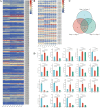Genome-wide identification and characterization of AP2/ERF gene superfamily during flower development in Actinidia eriantha
- PMID: 36100898
- PMCID: PMC9469511
- DOI: 10.1186/s12864-022-08871-4
Genome-wide identification and characterization of AP2/ERF gene superfamily during flower development in Actinidia eriantha
Abstract
Background: As one of the largest transcription factor families in plants, AP2/ERF gene superfamily plays important roles in plant growth, development, fruit ripening and biotic and abiotic stress responses. Despite the great progress has been made in kiwifruit genomic studies, little research has been conducted on the AP2/ERF genes of kiwifruit. The increasing kiwifruit genome resources allowed us to reveal the tissue expression profiles of AP2/ERF genes in kiwifruit on a genome-wide basis.
Results: In present study, a total of 158 AP2/ERF genes in A. eriantha were identified. All genes can be mapped on the 29 chromosomes. Phylogenetic analysis divided them into four main subfamilies based on the complete protein sequences. Additionally, our results revealed that the same subfamilies contained similar gene structures and conserved motifs. Ka/Ks calculation indicated that AP2/ERF gene family was undergoing a strong purifying selection and the evolutionary rates were slow. RNA-seq showed that the AP2/ERF genes were expressed differently in different flower development stages and 56 genes were considered as DEGs among three contrasts. Moreover, qRT-PCR suggested partial genes showed significant expressions as well, suggesting they could be key regulators in flower development in A. eriantha. In addition, two genes (AeAP2/ERF061, AeAP2/ERF067) had abundant transcription level based on transcriptomes, implying that they may play a crucial role in plant flower development regulation and flower tissue forming.
Conclusions: We identified AP2/ERF genes and demonstrated their gene structures, conserved motifs, and phylogeny relationships of AP2/ERF genes in two related species of kiwifruit, A. eriantha and A. chinensis, and their potential roles in flower development in A. eriantha. Such information would lay the foundation for further functional identification of AP2/ERF genes involved in kiwifruit flower development.
Keywords: AP2/ERF; Comparative genomics; Expression analysis; Flower development; Kiwifruit; Phylogenetic analysis.
© 2022. The Author(s).
Conflict of interest statement
The authors declare that they have no competing interests.
Figures







Similar articles
-
Genome-wide identification and expression profiling analysis of maize AP2/ERF superfamily genes reveal essential roles in abiotic stress tolerance.BMC Genomics. 2022 Feb 12;23(1):125. doi: 10.1186/s12864-022-08345-7. BMC Genomics. 2022. PMID: 35151253 Free PMC article.
-
Genome-wide identification and comprehensive analysis of NAC family genes involved in fruit development in kiwifruit (Actinidia).BMC Plant Biol. 2021 Jan 15;21(1):44. doi: 10.1186/s12870-020-02798-2. BMC Plant Biol. 2021. PMID: 33451304 Free PMC article.
-
Genome-wide investigation of the AP2/ERF gene family in ginger: evolution and expression profiling during development and abiotic stresses.BMC Plant Biol. 2021 Nov 25;21(1):561. doi: 10.1186/s12870-021-03329-3. BMC Plant Biol. 2021. PMID: 34823471 Free PMC article.
-
Genome-wide analysis of the AP2/ERF transcription factor superfamily in Chinese cabbage (Brassica rapa ssp. pekinensis).BMC Genomics. 2013 Aug 23;14:573. doi: 10.1186/1471-2164-14-573. BMC Genomics. 2013. PMID: 23972083 Free PMC article.
-
Genome-wide investigation of the AP2/ERF gene family in tartary buckwheat (Fagopyum Tataricum).BMC Plant Biol. 2019 Feb 20;19(1):84. doi: 10.1186/s12870-019-1681-6. BMC Plant Biol. 2019. PMID: 30786863 Free PMC article.
Cited by
-
Genome-wide identification and molecular characterization of the AP2/ERF superfamily members in sand pear (Pyrus pyrifolia).BMC Genomics. 2023 Jan 19;24(1):32. doi: 10.1186/s12864-022-09104-4. BMC Genomics. 2023. PMID: 36658499 Free PMC article.
-
Genome-wide identification and characterization of the chemosensory relative protein genes in Rhus gall aphid Schlechtendalia chinensis.BMC Genomics. 2023 Apr 28;24(1):222. doi: 10.1186/s12864-023-09322-4. BMC Genomics. 2023. PMID: 37118660 Free PMC article.
-
Molecular insights into drought tolerance in wheat through in-silico genome-wide analysis of DREB1 transcription factor and peroxidase interactions.BMC Plant Biol. 2025 Aug 29;25(1):1158. doi: 10.1186/s12870-025-06938-4. BMC Plant Biol. 2025. PMID: 40883672 Free PMC article.
-
Genome-wide identification, structural characterization and expression profiling of AP2/ERF gene family in bayberry (Myrica rubra).BMC Plant Biol. 2024 Nov 28;24(1):1139. doi: 10.1186/s12870-024-05847-2. BMC Plant Biol. 2024. PMID: 39604860 Free PMC article.
-
Genome-wide analysis of AP2/ERF gene family and functional characterization of StoERF109 in Solanum torvum response to Verticillium dahliae infection.Planta. 2025 May 20;262(1):1. doi: 10.1007/s00425-025-04723-z. Planta. 2025. PMID: 40392396
References
-
- Chen YH, Yang XY, He K, Liu MH, Li JG, Gao ZF, Lin ZQ, Zhang YF, Wang XX, Qiu XM, Shen YP, Zhang L, Deng XH, Luo JC, Deng XW, Chen ZL, Gu HY, Qu LJ. The MYB transcription factor superfamily of Arabidopsis: expression analysis and phylogenetic comparison with the rice MYB family. Plant Mol Biol. 2006;60(1):107–124. doi: 10.1007/s11103-005-2910-y. - DOI - PubMed
MeSH terms
Substances
LinkOut - more resources
Full Text Sources
Research Materials

